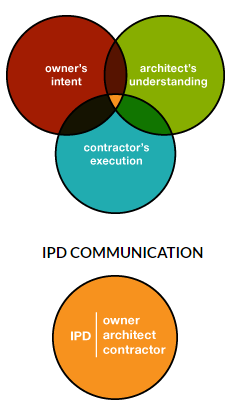Integrated Project Delivery (IPD)
| Line 17: | Line 17: | ||
There is no single definition for IPD. In fact, numerous definitions can be found throughout published studies and reports, some of the definitions continue to evolve. Mathews and Howell (2005) define IPD as “a relational contracting approach that aligns project objectives with the interests of key participants.” | There is no single definition for IPD. In fact, numerous definitions can be found throughout published studies and reports, some of the definitions continue to evolve. Mathews and Howell (2005) define IPD as “a relational contracting approach that aligns project objectives with the interests of key participants.” | ||
Formally, Integrated project delivery (IPD) is defined as a project delivery approach that integrates people, systems, business structures and practices into a process that collaboratively harnesses the talents and insights of all participants to optimize project results, increase value to the owner, reduce waste and maximize efficiency through all phases of design, fabrication, and construction | Formally, Integrated project delivery (IPD) is defined as a project delivery approach that integrates people, systems, business structures and practices into a process that collaboratively harnesses the talents and insights of all participants to optimize project results, increase value to the owner, reduce waste and maximize efficiency through all phases of design, fabrication, and construction | ||
| − | <ref name=''Integrated Project Delivery''> ''Integrated Project Delivery: A Guide https://www.aiacontracts.org/resources/64146-integratedproject-delivery-a-guide/ American Institute of Architecture (2007)'' </ref> . (American Institute of Architects) | + | <ref name=''Integrated Project Delivery: A Guide''> ''Integrated Project Delivery: A Guide https://www.aiacontracts.org/resources/64146-integratedproject-delivery-a-guide/ American Institute of Architecture (2007)'' </ref> . (American Institute of Architects) |
IPD principles can be applied to a variety of contractual arrangements and IPD teams can include members well beyond the basic triad of owner, architect, and contractor. In all cases, integrated projects are uniquely distinguished by highly effective collaboration among the owner, the prime designer, and the prime constructor, commencing at early design and continuing through to project handover. | IPD principles can be applied to a variety of contractual arrangements and IPD teams can include members well beyond the basic triad of owner, architect, and contractor. In all cases, integrated projects are uniquely distinguished by highly effective collaboration among the owner, the prime designer, and the prime constructor, commencing at early design and continuing through to project handover. | ||
Revision as of 15:09, 22 February 2019
Contents |
Abstract
Integrated project delivery (IPD) is an emerging construction project delivery system that aligns different stakeholders’ interests and objectives, while collaboratively involving key participants very early in the project timeline. It is distinguished by a multiparty contractual agreement that incentivizes collaboration and allows risks and rewards to be shared among the parties of the contract. IPD is becoming increasingly popular with various organizations expressing interest in its benefits to the construction industry. The objective of the article is to provide a description of the IPD method and a short discussion on how it has been rising as a promising method to avoid some of the inefficiencies of traditional contracting systems, as a way to reduce the conflictual relationships between the parties involved in construction projects and maximize construction project success. Furthermore, This article seeks to illustrate what are the main benefits of IPD and address the main obstacles that refrain from unlocking the value of IPD as a precursor of a larger adoption in the industry. IPD has emerged as a solution, although its implementation is not without challenges and limitations.
Definition
There is no single definition for IPD. In fact, numerous definitions can be found throughout published studies and reports, some of the definitions continue to evolve. Mathews and Howell (2005) define IPD as “a relational contracting approach that aligns project objectives with the interests of key participants.” Formally, Integrated project delivery (IPD) is defined as a project delivery approach that integrates people, systems, business structures and practices into a process that collaboratively harnesses the talents and insights of all participants to optimize project results, increase value to the owner, reduce waste and maximize efficiency through all phases of design, fabrication, and construction [1] . (American Institute of Architects)
IPD principles can be applied to a variety of contractual arrangements and IPD teams can include members well beyond the basic triad of owner, architect, and contractor. In all cases, integrated projects are uniquely distinguished by highly effective collaboration among the owner, the prime designer, and the prime constructor, commencing at early design and continuing through to project handover.
The current form of IPD was born out of the general belief that traditional contracting approaches create barriers to collaboration, transparency and the trust needed to truly collaborate; hence the rise of the multi-party agreement. The intent of the multi-party agreement is to create a contractual vehicle that removes barriers to collaboration (i.e., protecting profit, blaming others, hiding contingency and the mentality of every company for itself). There are many IPD proponent in the industry who believe this environment can only be created through the use of a multi-party agreement in which there are a shared risk/reward pool and no traditional financial cost guarantees.
Principles of Integrated Project Delivery
Integrated Project Delivery operates differently than conventional project management methods but often results in more productivity and efficiency and reduced risk and losses. The focus shifts from “how does my company succeed on this project” to “how do we ALL succeed on this project”.
Multi-Party Agreements
Benefits of IPD
Challenges/ Limitations
Bibliography
References
- ↑ Integrated Project Delivery: A Guide https://www.aiacontracts.org/resources/64146-integratedproject-delivery-a-guide/ American Institute of Architecture (2007)
